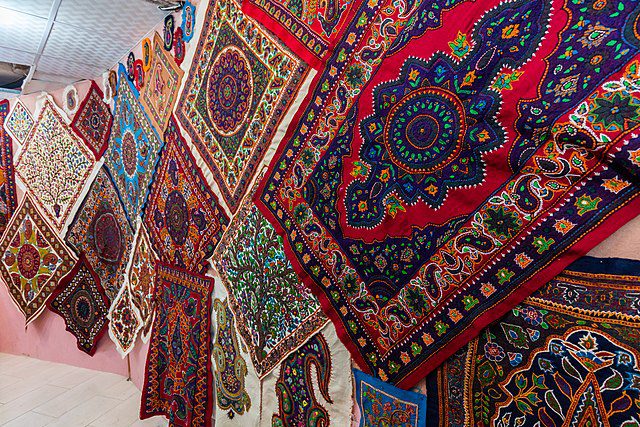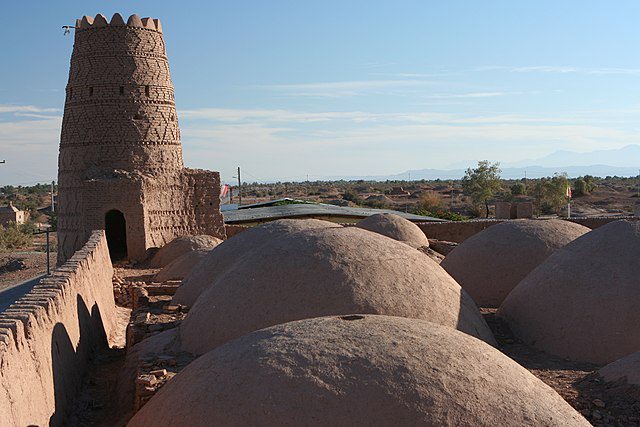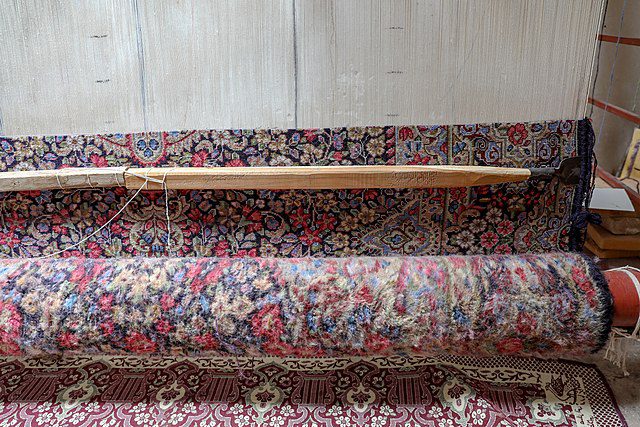Table of Contents
Kerman City: A Quick Review
While the ancient city of Kerman is celebrated as a city steeped in history, it also boasts a different kind of fame. Nestled in its arid landscapes are some of Iran’s finest pistachio farms, known far and wide for their top-notch produce. These pistachios, renowned for their quality, find their way to all corners of the globe, marking Kerman as a significant contributor to the world’s pistachio market.
The land’s bounty doesn’t stop there, for Kerman’s lush landscapes have also made animal husbandry a way of life for its people. This provides them with exceptional raw materials that weave into the rich tapestry of Kerman’s carpet craftsmanship. It’s no wonder that Kerman’s skilled artisans have earned a reputation as exceptional carpet weavers and stand proudly as Iran’s premier carpet exporters.
Kerman Carpets
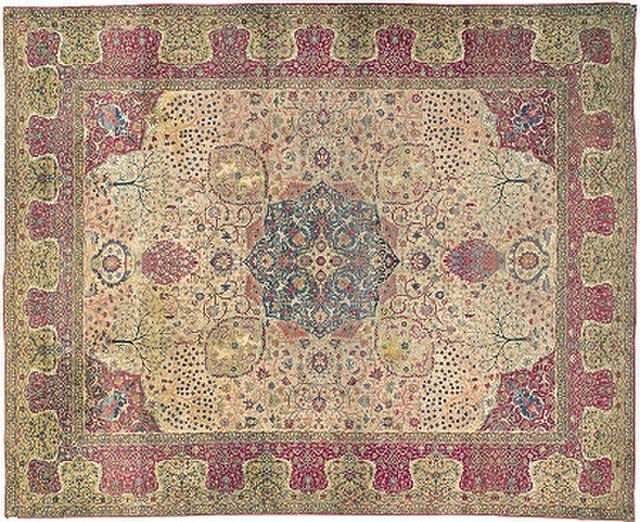
Situated far from the bustling city of Tehran, Kerman has a long history of crafting Persian carpets. In the past, these carpets were celebrated as the finest of their kind, though the quality has changed over time. Even so, Kerman carpets still belong to the top tier of hand-knotted rugs, upholding a cherished tradition deeply rooted in Kerman’s culture.
Kerman carpets are known for their vibrant red hues, complemented by soothing shades of beige. They often feature a beautiful medallion at the center, surrounded by intricate floral designs. This blend of colors and patterns infuses life into these carpets, each one telling a unique story. Crafted from high-quality sheep’s wool for the soft pile and cotton for the warp and weft, Kerman carpets may not have the highest knot density, with about 160,000 knots per square meter, but they maintain their cultural significance and timeless charm in the world of Persian rugs.
History of Kerman Carpet
Kerman’s history in rug weaving spans over five centuries, making it a revered hub for creating some of the world’s most cherished Persian rugs. The city’s skilled artisans have tirelessly passed down their age-old techniques from one generation to another. What sets Kerman rugs apart is not just their captivating aesthetics but also their remarkable durability, making them a true investment.
These rugs, adorned with one-of-a-kind patterns, have earned a well-deserved global reputation. Each Kerman rug tells a story of craftsmanship, a tale of artistry that transcends time and brings warmth and beauty to every space it graces.
Over the centuries, Kerman’s reputation for making rugs has only grown. People from far and wide appreciate the craftsmanship of Kerman’s rug makers. It’s not just a craft; it’s a tradition that connects the past with the present. These rugs aren’t just things to put on the floor; they’re treasures that pass along the culture and skill of Kerman’s people. So, when you have a Kerman rug in your home, you’re not just adding a beautiful decoration, you’re also bringing a piece of history and art into your life.
Characteristics of Kerman Carpet
Kerman rugs are celebrated for their intricate, winding designs and detailed patterns, weaving together a seamless fusion of both florals and geometric shapes. The color palette is a captivating dance of gentle pastels, deep blues, and opulent reds, forming a stunning tapestry of hues that captivate the eye.
These rugs typically feature prominent centerpieces, elaborate borders, and intricate corner elements, each a testament to Kerman’s vibrant cultural legacy and the imaginative spirit of its talented weavers. In every knot and curve, Kerman rugs narrate a story of artistry, painting the heritage of a city with threads of creativity.
Kerman Ravar (Lavar) Rugs
In the world of rug making, Kerman Ravar (Lavar) rugs stand out as incredible pieces of art. These rugs are made in the nearby town of Ravar and are known for their extremely delicate weaving and detailed designs, much like the brushstrokes in a painting. The patterns on Kerman Lavar rugs often depict stories, some from a long time ago, others from today, capturing the essence of a town famous for its weaving tradition.
These special rugs are crafted with great care and skill, connecting the past to the present. Each rug is a masterpiece that embodies the rich heritage of Kerman, a heritage that travels across the globe and finds a place in homes and hearts worldwide.
The creation of Kerman Lavar rugs showcases the exceptional abilities of the artisans who are devoted to this traditional craft. They meticulously choose the finest wool and silk threads and make sure that every knot is perfectly placed. This results in rugs that are not just functional but also pieces of art.
The soft colors and detailed designs on Kerman Lavar rugs reveal the various influences that have shaped the region’s history. Persian, Arab, and even European elements often blend together in a captivating mix of culture and design. Each rug becomes a historical tapestry, reflecting the passage of time. They are more than just decorative items; they also carry cultural significance.
As these rugs travel the world, they bring a part of Kerman’s spirit with them. They grace the floors of homes, adding warmth and elegance, and are often passed down through generations as beloved family heirlooms. The tradition of Kerman Lavar rugs lives on, not only sharing their origin stories but also the dedication and passion of the people who create them, making them timeless treasures in the realm of art and craftsmanship.
Things to Do in Kerman
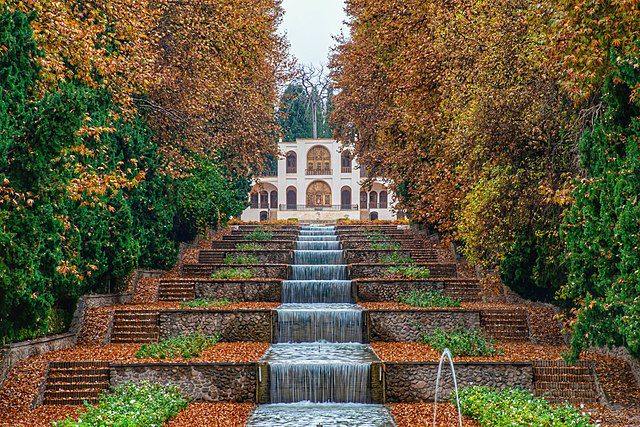
Kerman, a city with a deep history and a vibrant culture, welcomes visitors with a variety of fascinating experiences and attractions. Here are some of the top places to explore:
The Shazdeh Garden
A UNESCO World Heritage site, Shazdeh Garden, one of the beautiful Persian gardens, provides a peaceful retreat with its lush greenery and flowing water. It’s a serene place to escape and connect with nature’s beauty, a sanctuary for the spirit.
The Ganjali Khan Complex
This remarkable historical site includes a bathhouse, mosque, and bustling bazaar, offering a glimpse into Kerman’s rich architectural heritage. Walking through its passages feels like stepping back in time, surrounded by the echoes of days gone by.
Jameh Mosque of Kerman
This architectural marvel is not only a place of worship but also a testament to the city’s architectural prowess. The intricate tile work and design of this mosque make it a must-visit for history and art enthusiasts.
The Kerman Bazaar
A lively marketplace where you can watch local craftsmen at work and discover a wide range of traditional handicrafts, including exquisite Kerman rugs.
Exploring here offers a window into the city’s artistic heart, where the legacy of craftsmanship thrives. It is also a good opportunity to buy a Persian carpet as one of the best souvenirs from Iran.
FAQs about Kerman Carpet
Q1: Is it Kerman or Kirman rugs?
A1: Kerman carpets, also known as “Kirman” carpets, are a kind of traditional Persian rug. Kerman is a place in southern Iran, and this term can also refer to a specific style that might have been created in other areas.
Q2: Are Kerman rugs good quality?
A2: For many centuries, Kerman has been a significant place for making top-notch Persian rugs, starting from the 17th century. The Vase Carpets from the Safavid era are some of the most outstanding Persian rugs ever crafted.
Q3: What is a Persian Kerman rug?
A3: Kerman rugs are built with a base of soft cotton and silky Carmania wool, which makes them feel smooth and sturdy. They are called “vase carpets” because they feature intricate floral designs and big palmetto shapes that cover the entire rug. These carpets are typically seen in classic red and blue colors.
Q4: How do I identify a Kerman rug?
A4: Kerman rugs and carpets are easily recognizable among antique Persian rugs. They usually have a pattern with flowers or buildings in the main border and a central medallion in the middle.
Q5: Where do Kerman rugs come from?
A5: Kerman rugs come from the ancient city of Kerman in southeastern Iran. They are famous for their detailed patterns, excellent craftsmanship, and top-notch materials. Collectors and rug enthusiasts have admired these beautiful rugs for a long time because of their grace and sturdiness.
Last Words: Unlocking the Allure of Kerman Carpets with Customized Iran Tours
Kerman, a city far from Tehran, has a long history of making Persian carpets. Even though the quality has changed over time, Kerman carpets are still considered some of the best hand-knotted rugs. They are known for their bright red and calming beige colors, often featuring a center design and intricate floral patterns that make each carpet special. They’re made from good-quality sheep’s wool and cotton and, while they might not have the most knots per square meter, they’re still very important in Persian rug culture.
If you aspire to embark on a journey to Iran and immerse yourself in the world of exquisite Kerman Carpets, a custom-tailored tour may be the key to a truly remarkable experience. With Iran Tours designed and executed by To Iran Tour, you can be confident that your exploration of Kerman’s world-famous carpets will be an experience like no other. Our team of experts is dedicated to understanding your desires and crafting a personalized plan that not only covers the renowned Kerman Carpet weaving centers but also takes into account your specific interests.
Iran is waiting to be explored, and we’re ready to make it happen.

